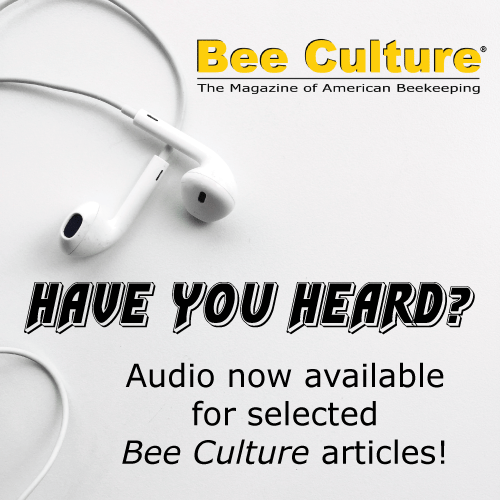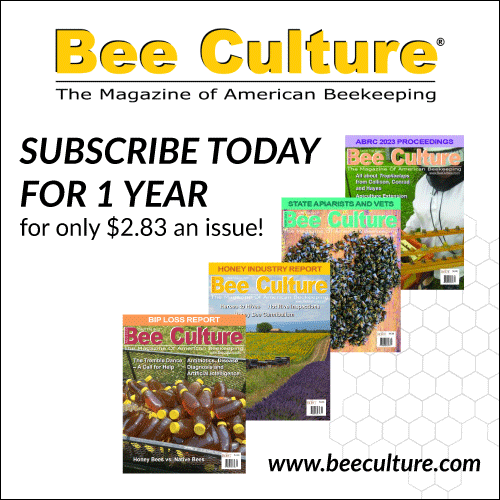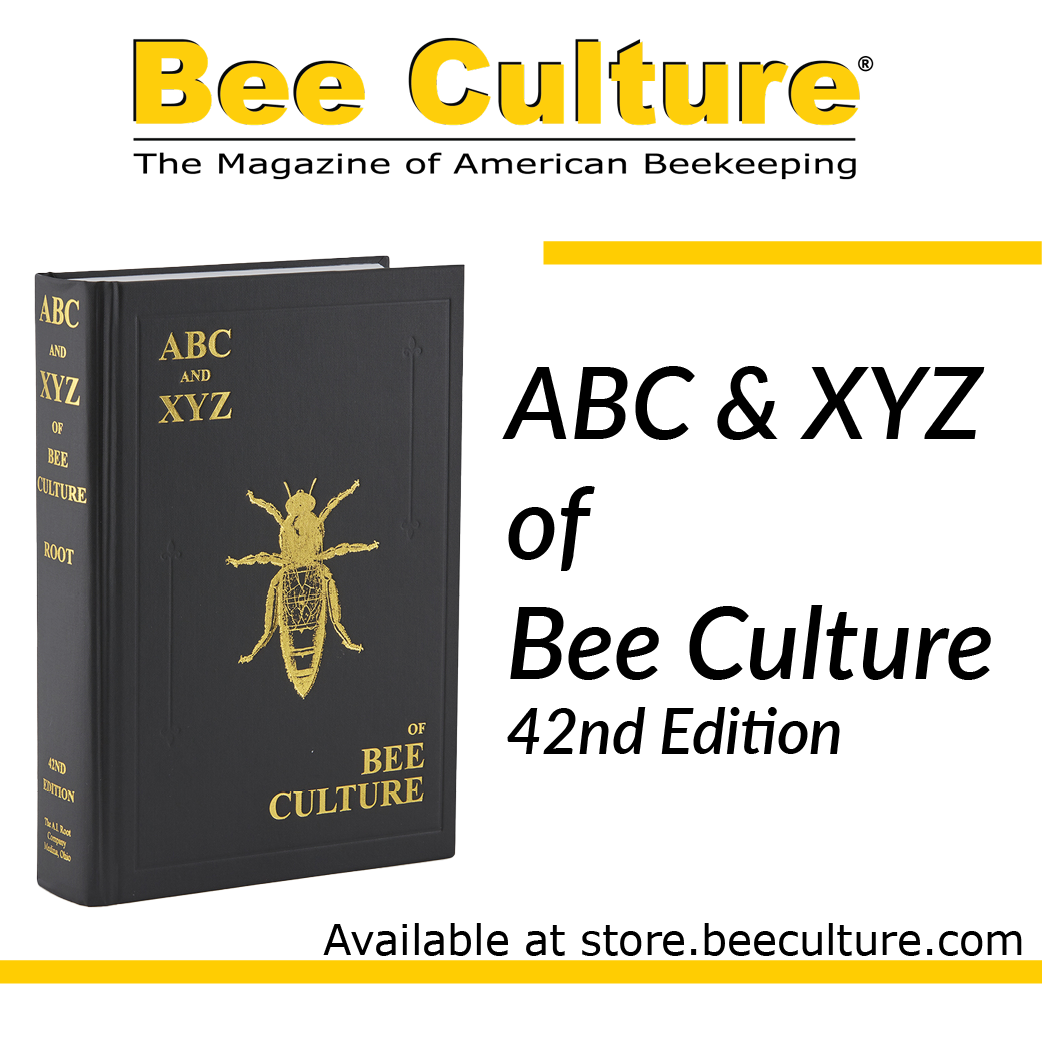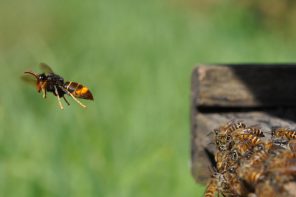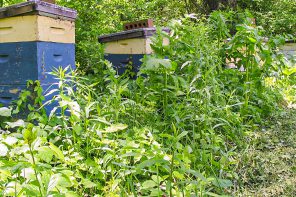Click Here if you listened. We’re trying to gauge interest so only one question is required; however, there is a spot for feedback!
Read along below!
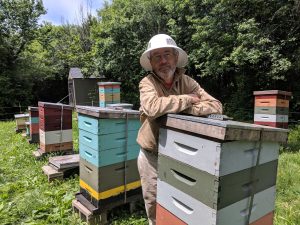
Pure Honey?
Probably Not So Much
By: Ross Conrad
Most widely known as components of Teflon coated cookware and firefighting foams, PFAS are extremely persistent in the environment. Researchers don’t really have a very good handle on how long it takes for them to actually break down, if they ever do, which is why they are sometimes referred to as forever chemicals.
PFAS Everywhere
Due to their unique properties, these chemicals are used in an extremely wide range of commercial, industrial and consumer products, including adhesives, building and construction materials, cleaning products, paints, varnishes and inks, cosmetics and personal care, dry cleaning, flea and tick products, electronics, explosives and ammunitions, the oil and gas industries, and the medical industry, among others (Gaines, 2021). A huge number of PFAS chemicals have been produced and distributed through the global supply chain, with over 9,000 PFAS related chemicals recorded dating back to before 1950 according to the Environmental Protection Agency Master list of PFAS substances (EPA).
High Level of Toxicity
Peer reviewed studies have connected exposure to certain PFAS chemicals to a host of human health problems including reproductive effects such as decreased fertility or increased high blood pressure in pregnant women, developmental effects or delays in children, increased risk of some cancers, suppression of the body’s immune system and interference with the body’s natural hormones, along with increased cholesterol levels and/or risk of obesity (EPA, 2023). Some of these chemicals are so toxic that in 2022, EPA released a lifetime drinking water health advisory for four PFAS substances – not in the amounts of parts per million, or parts per billion, but in the fractions of parts per trillion range (U.S. Gov., 2022).
Health effects associated with exposure to PFAS are difficult to nail down for many reasons. Although there are thousands of PFAS with potentially varying effects and toxicity levels, most studies have focused on a limited number of better known PFAS compounds. Meanwhile, people can be exposed to PFAS in different ways and at different stages of their life, and the types and uses of PFAS change over time. All of this makes it challenging to track and assess how exposure to these chemicals occurs and how they will affect human health.
Honey Bee Exposure
In the June issue of Bee Culture, I note that PFAS used in plastic manufacturing (most notably in high density and low density polyethylene – HDPE & LDPE) has the potential to leach out of plastic hive components and impact bees and honey. Well, it turns out there is yet another avenue for PFAS to potentially make its way into our hives: pesticides (Lasee et al., 2022).
PFAS chemicals are being found in a wide variety of pesticides. Sometimes, the PFAS is the active ingredient or added as an adjuvant, or so called “inert” ingredient included in the pesticide formulation to enhance the effectiveness of the active ingredient. Other times, the levels of PFAS found in a particular pesticide is so small it is likely a result of the chemical leaching out of plastic packaging and into the pesticide or its components prior or during manufacture. Since pesticides are applied to our food crops, researchers are documenting PFAS chemical build up (bioaccumulation) in fish, animals and people.
Officials in the state of Maine found that more than 1,400 pesticides contain active ingredients that meet the state’s definition of PFAS (EWG, 2023). Researchers have also documented the migration of toxic pesticides from the surrounding environment into honey bee colonies.
The common presence of PFAS in pesticides, potentially including those many beekeepers place in their hives, is concerning not just from a human perspective but also from the bee’s. A small but growing body of research reveals the potential for adverse impacts of PFAS exposure in honey bee colonies. One researcher found that a honey bee’s oral exposure to PFOS resulted in a 72-hour oral median lethal dose (LD50) of 0.40 mg per bee (Wilkins, 2001). Meanwhile, a correlation between the bioaccumulation of fluorinated pesticides in honey bees, along with other types of pesticides, and mass mortality events of honey bee colonies has been documented (Martinello et al., 2019). Another study found that not only do PFAS have the potential to adversely impact honey bees, they can migrate into honey, the primary source of carbohydrate and energy for honey bees and one of the primary hive products produced by beekeepers (Sonter et al., 2021). Given the well-established fact that pesticides are commonly found in honey samples, it should come as no surprise if further testing uncovers widespread PFAS contamination in honey sold for human consumption.
States Taking the Lead
PFAS contamination presents a mostly unexamined problem for farmers all across the country. Prior to the recent revelation of PFAS contamination of pesticides, farmland has historically been contaminated with PFAS through the spreading of waste water treatment plant sewage sludge as an agricultural fertilizer. Another acknowledged source of contamination is the leaching of PFAS chemicals off military bases onto nearby farms and water supplies.
As part of the effort to get a handle on this situation, Maine has become the first state to enact a comprehensive ban on pesticides that include intentionally added PFAS, as well as pesticides contaminated with PFAS. The ban is currently set to take effect in 2030.
A second state to move to ban PFAS is Minnesota. Scientist’s understanding and ability to detect PFAS in the environment has evolved greatly since the Minnesota Pollution Control Agency (MPCA) and the Minnesota Department of Health (MDH) began investigating them back in 2002. Laboratories at that time had only identified two PFAS and extremely low concentrations were undetectable given the existing technology at that time. Today, we are able to measure extremely small amounts (parts per trillion) of several PFAS. As noted before, studies have linked long-term exposure to PFAS in this range to negative outcomes especially for the most vulnerable members of our population: children, the elderly, pregnant women and those with compromised immune systems.
The writing is on the wall when it comes to PFAS compounds. One of the world’s primary PFAS manufacturing companies, 3M, has agreed to pay more than $10 billion to settle lawsuits claiming it knowingly used “forever chemicals” in its products despite being aware of risks to human health. Additionally, 3M says it’s phasing out two common compounds – PFOS and PFOA – and has announced that they will discontinue all types of the chemicals by 2026. Unfortunately, history has shown that companies usually only phase out a toxic compound when they have a replacement ready for market. Typically, the replacement is just as harmful as the compound it replaces, but it takes decades to accumulate the data showing harm and require the replacement chemical to also be withdrawn. Of course by then, yet another toxic replacement is found.

Regularly rotating old comb out of hives is one way beekeepers can reduce toxic chemical loads on bee colonies. The color of the comb is not a reliable indication of the age of the comb, since combs that are only used by the bees or food storage take much longer than brood combs to darken.
Varroa Treatments
The commonly used beekeeping pesticide Amitraz (sold as Apivar) was not found to contain any fluorinated chemicals that would meet the state of Maine’s definition of PFAS. However, Fluvalinate, the active ingredient in Apistan does meet the state’s definition.
I spoke with pesticide toxicologist, Pam Bryer of the Maine Board of Pesticide Control who pointed out that the PFAS problem could easily have been avoided if all chemicals were treated like pesticides which are regularly tested for their persistence in the environment. According to Bryer, “for most of the PFAS out there, there is almost no data.” Bryer assured me that unlike PFOS and PFOA which are long chain fluorinated compounds, fluvalinate is not nearly as toxic since it contains a short chain fluorinated methyl group. She did express concern, however what can happen should the fluorinated methyl group in fluvalinate combine with other chemicals potentially forming more toxic compounds or potent green-house gases.
Better Safe Than Sorry
In my mind, the safest treatments available to beekeepers today are those that utilize organic acids. By definition, the acids are not toxic, though they are corrosive. All of the organic acids (formic, oxalic and hop beta) that are approved for use to control varroa mites become neutralized over time and leave behind no harmful residue from the acid. Unfortunately, we now know that PFAS have the potential to make their way into such otherwise relatively safe products and contaminate our colonies despite our best efforts.
Beekeepers don’t have to wait for regulatory action and should consider increasing their reliance on natural and organic approaches, or when possible, treatment-free management techniques to control mites. As beekeepers, we can reduce or even eliminate toxic chemical use in our hives starting today by incorporating organic practices into our hive management. One way is to regularly rotate old combs out of hives and allow colonies to build new comb so the level of residue buildup in wax remains relatively low. Another approach discussed in my book, Natural Beekeeping, includes the use of screened bottom boards, culling capped drone brood, forcing a brood break in the hive, and propagating strains of bees that show some resistance to mites and diseases. A trial that ran between 2016-2019 found that combining all five of these physical and biological treatment-free management approaches can control mite-related hive mortality and ensure survivability on par with commercially available pesticide treatments (Conrad, 2021).
Recently, researchers Robyn Underwood, Margarita López-Uribe and their team from Penn State and Virginia Tech published a study on organic beekeeping in which they “… found that the organic management system-which uses organic-approved chemicals for mite control-supports healthy and productive colonies, and can be incorporated as a sustainable approach for stationary honey-producing beekeeping operations.” (Underwood et al., 2023).
As Rachel Carson noted over 60 years ago: “The most alarming of all man’s assaults upon the environment is the contamination of air, earth, rivers and sea with dangerous and even lethal, materials. This pollution is for the most part irrecoverable; the chain of evil it initiates not only in the world that must support life, but in living tissues is, for the most part, irreversible.” (Carson, 1962). Given that we now have effective low toxic and non-toxic alternatives to dangerous chemicals, why continue to play Russian roulette with pesticides?
Ross Conrad is author of Natural Beekeeping, Revised and Expanded 2nd edition, and co-author of The Land of Milk and Honey: A history of beekeeping in Vermont.
References:
Carson, Rachel (1962) Silent Spring, The Riverside Press Cambridge, Houghton Mifflin Company, Boston pg 6
Conrad, Ross (2021) Comparison of a commercial Varroa mite honey bee treatment with treatment-free Varroa management techniques, Bee Culture September: pp 41-45
Environmental Protection Agency, Comptox Chemicals Dashboard: Master List of PFAS Substances (Version 2). Accessed June 26, 2023. https://comptox.epa.gov/dashboard/chemical_lists/pfasmaster
Environmental Protection Agency (2023) Our current understanding of the human health and environmental risks of PFAS, accessed June 21, 2023 https://www.epa.gov/pfas/our-current-understanding-human-health-and-environmental-risks-pfas
Environmental Working Group (EWG), Maine data unveils troubling trend: 55 PFAS-related chemicals in over 1400 pesticides, accessed June 13, 2023 – https://www.ewg.org/news-insights/news-release/2023/06/maine-data-unveils-troubling-trend-55-pfas-related-chemicals
Gaines, Linda G.T. (2001) Historical and current usage of per- and polyfluoralkyl substances (PFAS): A literature review, American Journal of Industrial Medicine, 66:353-378
Lasee, S. et. al. (2022) Targeted analysis and total oxidizable precursor assay of several insecticides for PFAS, Journal of Hazardous Materials Letters, 3:100067
Martinello, M. et. al. (2019) A survey from 2015 to 2019 to investigate the occurance of pesticide residues in dead honey bees and other matrices related to honey bee mortality incidents in Italy, Diversity, 12(1):15
McCarthy, C., Kappleman, W. & DiGuiseppi, W. (2017) Ecological Considerations of Per- and Polyfluoroalkyl Substances (PFAS). Curr Pollution Rep 3, 289–301
Steven Lasee, Kaylin McDermett, Naveen Kumar, Jennifer Guelfo, Paxton Payton, Zhao Yang, Todd A. Anderson, (2022) Targeted analysis and Total Oxidizable Precursor assay of several insecticides for PFAS, Journal of Hazardous Materials Letters, Vol. 3.
Sonter, C., Rader R., Stevenson, G., Stavert, J., Wilson, S.C. (2021) Biological and behavioural responses of European honey bee (Apis mellifera) colonies to perfluorooctane sulfonate (PFOS) exposure, Integrated Environmental Assessment and Management, 17(2)
United States Government (2022) Lifetime Drinking Water Health Advisories for Four Perfluoroalkyl Substances [FRL 9855-01-OW], Federal Register 87:118 pp 36848-36849
Underwood, R.M., Lawrence, B.L., Turley, N.E., Cambron-Kopco, L.D., Kietzman, P.M., Traver, B.E., López-Uribe, M.M. (2023) A longitudinal experiment demonstrates that honey bee colonies managed organically are as healthy and productive as those managed conventionally, Scientific Reports, 13:6072 https://doi.org/10.1038/s41598-023-32824-w
Wilkins, P. (2001) “Perfluorooctanesulfonate, potassium salt (PFOS): An acute contact toxicity study with the honey bee. Study number HT5601.”

